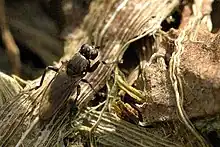Sphaeroceroidea
Sphaeroceroidea is a superfamily of flies. It includes the cosmopolitan families of Sphaeroceridae (small dung flies), Heleomyzidae, and Chyromyidae, as well as a few smaller groups.[1] It has about 2,600 species.[2]
| Lesser dung flies and allies | |
|---|---|
 | |
| Limosina silvatica | |
| Scientific classification | |
| Domain: | Eukaryota |
| Kingdom: | Animalia |
| Phylum: | Arthropoda |
| Class: | Insecta |
| Order: | Diptera |
| Section: | Schizophora |
| Subsection: | Acalyptratae |
| Superfamily: | Sphaeroceroidea |
| Families | |
| |
Description
Sphaeroceroids tend to be small flies a few millimetres in length.[3][4][5] Each of the families has its own distinguishing traits. For example, Sphaeroceridae have black wings with an interrupted costa, and the first tarsomere of the hind leg is short and thick.[5] Nannodastiidae are even smaller than usual for sphaeroceroids, with adults being 0.70-1.25 mm long, and their legs lack long setae.[6]
Ecology
Larvae generally live and feed on various kinds of decaying organic matter, including manure, seaweed, fungi, rotting wood, compost and carrion.[3][4][5]
Nannodastiidae have a more restricted lifestyle. Adults have usually been found in tropical and subtropical beaches, often in caves or under cliff overhangs. The larvae are unknown, but they may be in the droppings of birds and mammals which are abundant in such habitats.[6]
Taxonomy
The taxonomic composition of Sphaeroceroidea has been disputed. In 2007, there was a proposal to combine the families Heleomyzidae and Sphaeroceridae into one family, Heteromyzidae.[7] Other, more recent studies have kept these two families separate.[1][2]
Phylogeny
A 2021 study confirmed that the superfamily is monophyletic. Additionally, it found that Sphaeroceroidea is the sister group to all other Schizophora.[2]
References
- Kahanpää, Jere (2014-09-19). "Checklist of the fly families Chyromyidae and Heleomyzidae (Diptera) of Finland". ZooKeys. Pensoft Publishers (441): 319–324. doi:10.3897/zookeys.441.7507. ISSN 1313-2970. PMC 4200468. PMID 25337028.
- Bayless, Keith M.; Trautwein, Michelle D.; Meusemann, Karen; Shin, Seunggwan; Petersen, Malte; Donath, Alexander; Podsiadlowski, Lars; Mayer, Christoph; Niehuis, Oliver; Peters, Ralph S.; Meier, Rudolf; Kutty, Sujatha Narayanan; Liu, Shanlin; Zhou, Xin; Misof, Bernhard (2021). "Beyond Drosophila: resolving the rapid radiation of schizophoran flies with phylotranscriptomics". BMC Biology. 19 (1): 23. doi:10.1186/s12915-020-00944-8. ISSN 1741-7007. PMC 7871583. PMID 33557827.
- "Family Chyromyidae". bugguide.net. Retrieved 2022-10-24.
- "Family Heleomyzidae". bugguide.net. Retrieved 2022-10-24.
- "Family Sphaeroceridae - Lesser Dung Flies". bugguide.net. Retrieved 2022-10-24.
- Papp, L.; Mathis, W. N. (2001). "A review of the family Nannodastiidae (Diptera)". Proceedings of the Entomological Society of Washington. 103 (2): 337–348.
- McAlpine, David K. (2007-08-29). "Review of the Borboroidini or Wombat Flies (Diptera: Heteromyzidae), with reconsideration of the status of families Heleomyzidae and Sphaeroceridae, and descriptions of femoral gland-baskets". Records of the Australian Museum. 59 (3): 143–219. doi:10.3853/j.0067-1975.59.2007.1487. ISSN 0067-1975.
 Data related to Sphaeroceroidea at Wikispecies
Data related to Sphaeroceroidea at Wikispecies